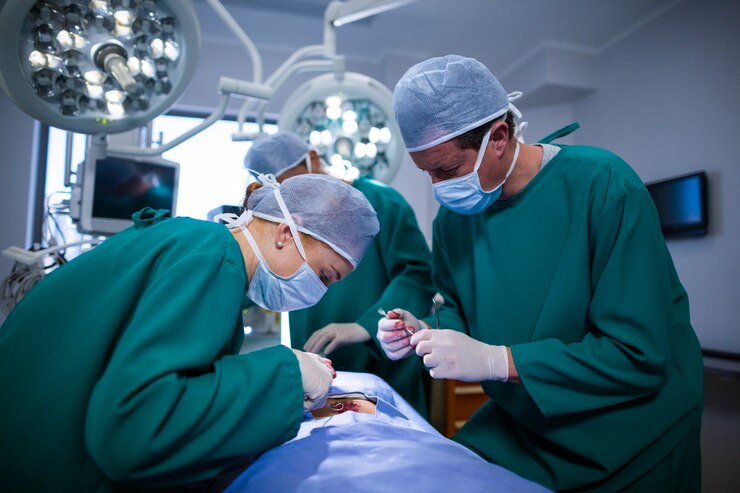Laparoscopic surgery, also known as minimally invasive surgery, has revolutionized the field of surgical medicine by offering patients less invasive procedures, shorter recovery times, and reduced postoperative complications compared to traditional open surgery. As technology continues to advance, the future of laparoscopic surgery holds even more promise, with ongoing innovations and emerging technologies poised to further enhance surgical outcomes, expand the scope of procedures, and improve patient care. In this article, we explore the latest trends and future directions in laparoscopic surgery, highlighting key innovations and technological advancements shaping the field.
Robotic-Assisted Surgery
Robotic-assisted surgery represents a significant advancement in laparoscopic techniques, offering surgeons enhanced precision, dexterity, and control during procedures. Robotic systems such as the da Vinci Surgical System enable surgeons to perform complex maneuvers with greater accuracy and efficiency, allowing for minimally invasive treatment of a wide range of conditions, including colorectal surgery, gynecological procedures, and urological interventions.
The integration of advanced imaging, three-dimensional visualization, and intuitive robotic interfaces enables surgeons to navigate anatomical structures with enhanced depth perception and spatial awareness, reducing the risk of complications and improving patient outcomes. As robotic technology continues to evolve, future developments may include smaller, more agile robotic platforms, improved haptic feedback, and augmented reality interfaces, further enhancing the capabilities of robotic-assisted laparoscopic surgery.
Single-Incision Laparoscopic Surgery (SILS)
Single-incision laparoscopic surgery (SILS), also known as single-port surgery or scarless surgery, represents a minimally invasive approach that utilizes a single small incision through which multiple surgical instruments are inserted. SILS offers several potential advantages over traditional multi-port laparoscopy, including reduced postoperative pain, improved cosmetic outcomes, and faster recovery times.
Emerging technologies in SILS include specialized access ports, flexible endoscopic instruments, and advanced imaging systems that enable surgeons to perform complex procedures through a single incision with precision and efficiency. Additionally, advancements in robotic-assisted SILS platforms offer further opportunities to expand the scope and complexity of procedures performed through a single access point, paving the way for scarless surgery across a wide range of surgical specialties.
Natural Orifice Transluminal Endoscopic Surgery (NOTES)
Natural orifice transluminal endoscopic surgery (NOTES) represents a revolutionary approach to minimally invasive surgery that eliminates the need for external incisions. Instead of accessing the surgical site through traditional abdominal incisions, NOTES procedures utilize natural orifices such as the mouth, vagina, or rectum as entry points for endoscopic instruments.
NOTES offers several potential benefits, including reduced postoperative pain, decreased risk of surgical site infections, and improved cosmetic outcomes. However, challenges such as instrument triangulation, tissue manipulation, and access to deep intra-abdominal structures have limited the widespread adoption of NOTES techniques.
Augmented Reality and Surgical Navigation
Augmented reality (AR) and surgical navigation technologies hold immense potential for enhancing the accuracy and precision of laparoscopic procedures. By overlaying digital images, anatomical landmarks, and real-time surgical data onto the surgeon’s field of view, AR systems provide valuable visual guidance and assistance during complex surgical tasks.
Surgical navigation systems utilize preoperative imaging data, intraoperative tracking, and advanced algorithms to assist surgeons in navigating complex anatomical structures, identifying critical landmarks, and planning optimal surgical trajectories. By enhancing spatial orientation, depth perception, and procedural accuracy, AR and surgical navigation technologies enable surgeons to perform laparoscopic procedures with greater confidence and efficiency, leading to improved patient outcomes and reduced surgical complications.
Nanotechnology and Miniaturized Instruments
Nanotechnology and miniaturized instrumentation hold promise for further miniaturizing laparoscopic instruments, enabling surgeons to perform highly precise and delicate maneuvers with minimal tissue trauma. Nano-scale surgical instruments, equipped with advanced sensors, actuators, and imaging capabilities, offer unprecedented control and precision in manipulating tissues, vessels, and organs during laparoscopic procedures.
Additionally, miniaturized robotic platforms and micro-endoscopic devices enable access to confined anatomical spaces and facilitate navigation through complex surgical environments. By leveraging the unique properties of nanomaterials and micro-scale technologies, future laparoscopic procedures may achieve even greater levels of precision, safety, and efficacy, ultimately benefiting patients through improved surgical outcomes and faster recovery times.
Conclusion
The future of laparoscopic surgery is characterized by ongoing innovation, technological advancement, and the relentless pursuit of excellence in patient care. From robotic-assisted surgery and single-incision techniques to natural orifice transluminal surgery and augmented reality navigation, emerging technologies are transforming the landscape of minimally invasive surgery and pushing the boundaries of what is possible in surgical medicine.
As these innovations continue to evolve and mature, surgeons, researchers, industry partners, and regulatory agencies need to collaborate closely to ensure the safe and effective integration of new technologies into clinical practice. By embracing innovation, fostering interdisciplinary collaboration, and prioritizing patient-centered care, the future of laparoscopic surgery holds immense promise for revolutionizing surgical medicine and improving the lives of patients worldwide.

